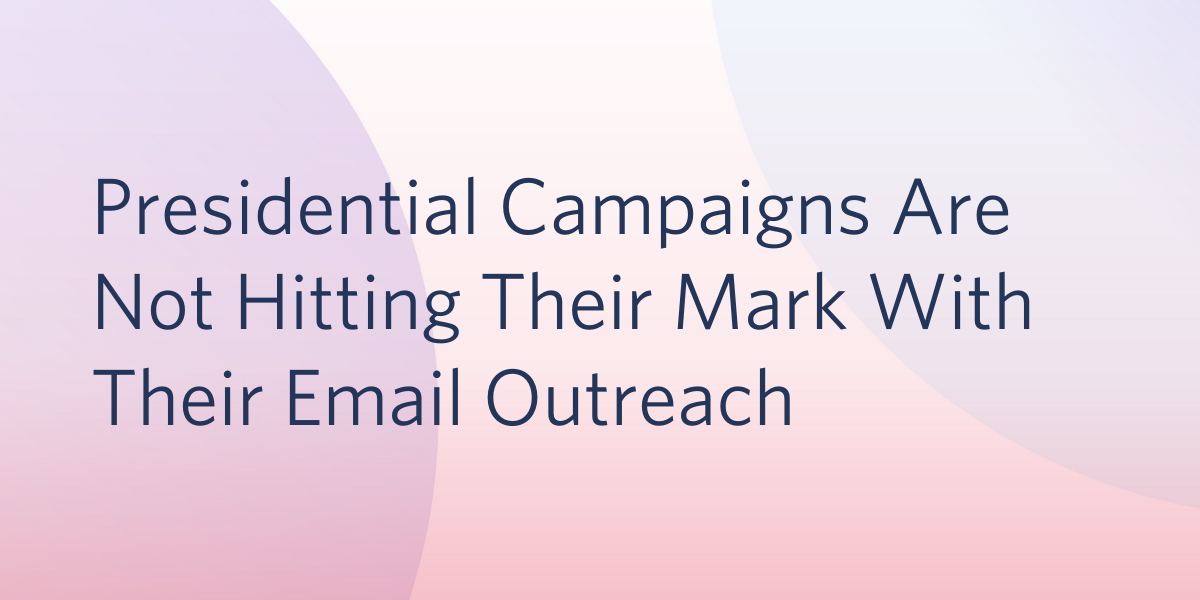TWILIO STUDY: Presidential Campaigns Are Not Hitting Their Mark With Their Email Outreach
Time to read: 3 minutes

If it feels like today’s election season has neither an end, nor a beginning, you may not be far off the mark. The 2020 presidential campaign kicked off barely minutes after the 2018 midterm elections. Between the start of 2019 through this fall, the field of presidential candidates plus the incumbent swelled to 26 individuals running for the top job in the country. As we head into Q4, the field has narrowed a bit on the Democratic side. However, the one thing that has remained constant since the beginning is that these candidates use email to engage potential voters, raise campaign contributions and educate subscribers about their platforms and messages.
Between July and August of 2019 we decided to take a close look at how political campaigns leverage email as part of their digital strategy. Our methodology was simple but effective given the diverse group of candidates. We set up a single Gmail address that we used to subscribe to every presidential candidate and the incumbent’s political campaign. When prompted to enter a zip code we submitted the same San Francisco zip code for those campaigns that collected them. When and if we were asked for a phone number we used a single number that we could monitor and track to see if the campaign was leveraging SMS.
We monitored emails sent to our Gmail address for 30 days. During that time period we simply tabulated where they landed: primary tab, promotions tab or the spam folder. We purposefully didn’t open any emails, mark any as not spam, mark anything as spam, forward or reply to messages in this email account to keep it as “default” as possible. Our hope was to understand how campaigns send email, the frequency, design nuances, authentication employed and other variables commonly associated with email best practices through the lens of a political campaign. Compared to businesses and corporations, campaigns typically have a short life-span, ranging anywhere from a few months to about a year and a half.
We collected our findings in a white paper that explores how political campaigns send email, the kind of platforms they employed and whether or not they were actually reaching their intended audiences. We also recommend a set of best practices for campaigns to consider to improve everything from the transparency of who is sending the email to better protecting the candidate’s brand from phishing and spoofing by employing aligned email authentication with a reject policy. The latter is key given that we’ve seen foreign state actors interfere with the United States’ free and fair elections. Taking steps to better ensure that the candidates’ email from address and domain are hardened against spoofing are critical to protecting the message and platform. A few of our key findings included:
- Only 3.8% of all the messages received landed in the primary tab of our test account. The primary tab in a Gmail account is the first thing a recipient sees upon opening Gmail in a web browser. Tabs help users separate out what is personal and direct (based on Google’s Algorithms, and that which is promotional or from social networks or spam). Default accounts in Gmail are created with a PRIMARY, SOCIAL and PROMOTIONAL tab.
- 21.3% of all the messages our test account received landed in the spam folder, even though we had submitted our contact information and consented to receive emails. This is a major problem for campaign managers that are looking to make an impact in the inbox. The spam folder is associated with unsolicited commercial email and possibly abusive and deceptive messaging. Many users don’t check their spam folder—of further concern is that email from the spam folder is deleted on a 30 day rolling basis by default in Gmail, which means that messages could vanish altogether without ever having been seen.
- 74.8% of the messages received by our test account landed in the promotions folder. The promo- tions folder is meant to capture and store commercial and promotional content. Gmail’s algorithms determined that most of the political email messages sent by the campaigns should be sorted in the promotional tab. Although it may seem like the promotional tab is not where a campaign wants their email to land it is important to remember that tabs don’t exist on Apple mail and other native mobile email clients. Based on a ReturnPath study recipients do check the promotional tab but at a lower frequency than their primary tab.
There is still time for the remaining presidential campaigns to improve their outreach to those who have consented to receive their communications. Regardless of the peculiar nature of presidential campaigns, the same basic fundamentals still apply to ensure effective email outreach. To learn about all of our findings and our recommendations for best practices, download the full report here. To read our press release click here.
Len Shneyder is a 15+ year email and digital messaging veteran and the VP of Industry Relations at Twilio SendGrid. He can be reached at lshneyder [at] twilio.com.
Related Posts
Related Resources
Twilio Docs
From APIs to SDKs to sample apps
API reference documentation, SDKs, helper libraries, quickstarts, and tutorials for your language and platform.
Resource Center
The latest ebooks, industry reports, and webinars
Learn from customer engagement experts to improve your own communication.
Ahoy
Twilio's developer community hub
Best practices, code samples, and inspiration to build communications and digital engagement experiences.